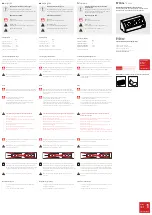
Console Diagnostic Screens
38
11. Current streak of consecutive packets received.
12. Graph of the percentage of scheduled ISS data packets received over the
last 24 days.
13. Background noise level.
The background noise level refers to the undesirable signal level the con-
sole hears while it is in the process of acquiring a signal from a station. The
range displayed is from 5 to 60. When the noise level is high, try to move
the console closer to the station to get a stronger signal. Small background
noise level does not always guarantee good reception. The signal strength
between the station and the console needs to be stronger than the back-
ground noise level in order for the console to receive clearly. If there are
reception problems while a small background noise level is still being dis-
played, make sure the console is within reasonable range of the ISS.
If the console has currently acquired all the station signals it is set to
receive, the background noise level displayed is the last noise level mea-
surement taken before acquisition.
Note:
Receiver Gain Status is an alternate view that is displayed for consoles with firmware versions of
May 2005 or earlier. For consoles in which Background Noise Level displays, the receiver gain is
automatically adjusted to obtain the best sensitivity and does not need to be controlled manually.
13. Alternate View: Receiver Gain Status
Some versions of the console display receiver gain status and not back-
ground noise level. The receiver gain status setting allows you to control
the gain setting of the console. Press HI/LOW to toggle Gain on and off.
The message in the ticker indicates the current Gain status. The Receiver
Gain setting provides some control over the receiver sensitivity. If you’re
having trouble with reception, try turning the Gain on.
Note:
Gain can adversely affect performance when signal strength is high. Gain should generally not be
turned on when signal strength is above 30.
14. Current console battery voltage.
15. Repeater ID currently communicating with console.
If a repeater or group of repeaters is used to relay station information to the
console, the Repeater ID closest to the console is displayed. If the console
is not listening to repeaters, the section remains blank.
16. The console’s reception status. See “Troubleshooting Reception Problems”
on page 35 for information on the status types.
Reception Diagnostic Screen
The Reception Diagnostic screen displays information pertinent to the con-
sole’s wireless reception. To view this screen from the Statistical Diagnostic
screen, press 2ND and then press CHILL.
















































